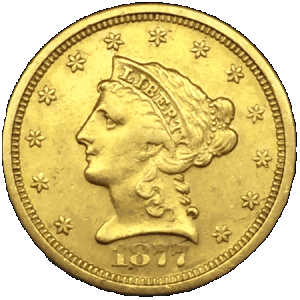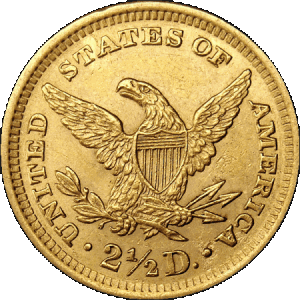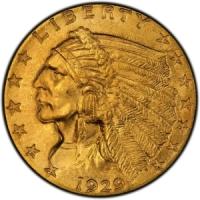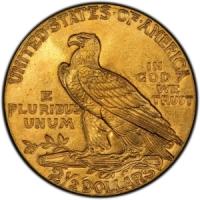Liberty Quarter Eagles

 $2.50 Liberty Gold Quarter Eagles - with unchanged design for 68 years
$2.50 Liberty Gold Quarter Eagles - with unchanged design for 68 years
The US Mint produced the $2.50 Liberty Gold Quarter Eagles for quite a long period between 1840 and 1907. Close to 12 million Liberty Quarter Eagles were minted during this time at the mint's facilities in Philadelphia, New Orleans, San Francisco, Charlotte and Dahlonega. Proof $2.50 Quarter Eagles are very rare gold coins though since proof coins were exclusively minted in Philadelphia in very small numbers. The Liberty Gold Quarter Eagles were succeeded by the $2.50 Indian Gold Quarter Eagles in 1908.
The Liberty Head Quarter Eagles were made of 90% gold and 10% copper with each coin containing 0.12094 oz of gold. The obverse side of the coins shows a leftward facing Lady Liberty in profile. An eagle that is holding a shield can be seen on the reverse. If you want to buy gold coins with these common designs, you might also want to have a look at the $10 Liberty Gold Eagles and $5 Liberty Gold Half Eagles.
Unlike most other pre-1933 U.S. gold coins that underwent significant changes in their design during their mintage period, the Liberty Gold Quarter Eagle basically maintained the same design throughout. The 1848 CAL issue is a rare and valuable exception to this rule. American buyers that are investing in gold for their retirement should take note that the coins are not eligible for inclusion in Individual Retirement Accounts (IRA's) since they are classified as collectible gold coins by the IRS.


Coin Fact Sheet
| Weight | Face Value | Purity | Diameter |
|---|---|---|---|
| 0.12094 oz | US $ 2.50 | 90% | 18 mm |
Total Mintage: 11,872,378
Liberty Quarter Eagle Coin Design
The obverse side of the $2.50 Liberty Gold Quarter Eagle depicts a leftward facing Lady Liberty in profile in the style of Greco-Roman sculptures. She wears a pearl crown that has "Liberty" inscribed on it. Thirteen stars appear along the outer edge of the coin, representing the 13 original colonies of the United States of America. The year of mintage is inscribed underneath Lady Liberty's portrait.
The motif on the reverse side of the Liberty Quarter Eagle gold coin is derived from the Great Seal of the United States. It shows an eagle with a shield holding an olive branch and arrows. The coin's $2.50 face value (2 ½ D.) and "UNITED STATES OF AMERICA" are engraved along the coin's edge. Liberty Quarter Eagles that were minted in New Orleans (mint mark: O), San Francisco (mint mark: S), Charlotte (mint mark: C) or Dahlonega (mint mark: D) contain a mint mark just above the face value and underneath the eagle's claws. However, coins that were minted at the main Philadelphia branch of the United States Mint don't have any mint mark.
History of the $2.50 Liberty Gold Quarter Eagle
As a result of the Coinage Act of 1792, many gold coins were introduced in the years that followed by the US Mint. The $2.50 Liberty Gold Quarter Eagles were minted continuously from 1840 to 1907. The Liberty Head design that was created by the US Mint's engraver Christian Gobrecht appears on many other gold coins that were minted during this period.
In 1908, the Indian Head Quarter Eagle replaced the Liberty Head Quarter Eagle.
Even though production of the Liberty Head $2.50 gold coins lasted from 1840 to 1907, only the US Mint in Philadelphia produced them every year during this period (though the number of coins minted in Philadelphia in 1841 is unknown and only proofs were struck in 1863).
Coin Variations
A special variety of the coins was minted in 1848, known as the California or CAL issue. These 1,389 coins bear the letters CAL just above the eagle design on the reverse. The three letters were punched in manually after the minting process. The CAL coins were minted in Philadelphia as well but use gold that was mined during the 1848 California Gold Rush. The 1848 "CAL" Quarter Eagle is widely considered to have been the first commemorative coin of the United States. No more than 150 such coins are believed to still exist today.
Rare Dates
Besides the 1848 CAL issue (1,389 coins), coins from several years and/or mint facilities are very rare these days for example the coins minted in Dahlonega in 1840 (3,532 coins), 1854 (1,760 coins), 1855 (1,123 coins) and 1856 (874 coins).
The coins minted in Philadelphia are hard to find for the year 1841 (unknown mintage), 1864 (2,824 coins), 1865 (1,520 coins) and 1875 (400 coins). Proof coins are even rarer to find if at all possible. Proof mintage of the Liberty Head version of the $2.50 Quarter Eagle never exceeded a maximum of 223 pieces per year. In 1863, the mint in Philadelphia only produced 30 proof coins and no 'regular' coins.
Mintage Numbers
Annual mintage numbers of the Liberty Quarter Eagle at the various US Mint branches varied between 246 coins (San Francisco 1854) and 1,404,668 coins (Philadelphia 1853). Proof coins were exclusively minted at the Philadelphia branch of the US Mint and proof mintage varied between 20 coins and 223 coins (1901). Actual proof mintage for the years 1840 to 1858 is unknown but is estimated to have varied between 5 and 20 coins per year.


Indian Gold Quarter Eagles
The $2.50 Indian Gold Quarter Eagles succeeded the $2.50 Liberty Gold Quarter Eagles in 1908. The US Mint produced them with a period of interruption from 1908 to 1929. The coins were struck at the US Mint facilities in Philadelphia and Denver. Their composition is 90% gold and 10% copper with each coin containing 0.12094 oz of gold. More than 7 million Indian Quarter Eagles were minted. However, only a small amount were minted in proof condition at the Philadelphia facility. The obverse of the coins shows a Native American Indian Chief wearing a traditional headdress. An eagle that is standing on a bundle of arrows and an olive branch can be seen on the reverse.
The Indian Gold Quarter Eagle page gives more information about the coins and allows you to compare current prices.